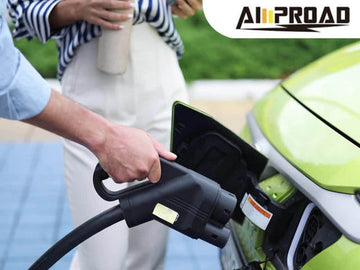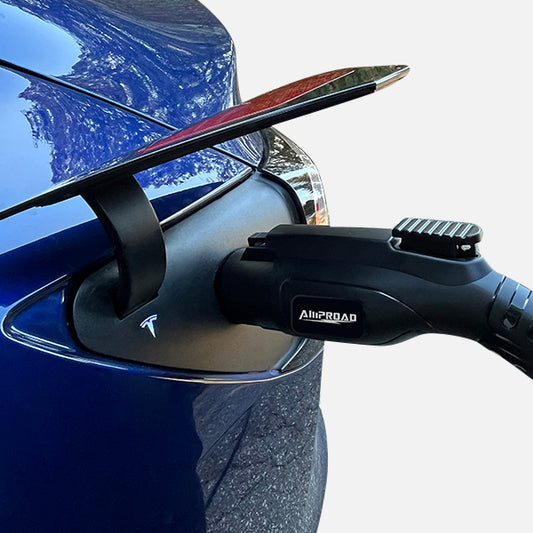
Starting your journey into electric vehicle charging means encountering terms like EVSE and EVCS. Understanding the difference between these acronyms is essential for navigating the world of EV infrastructure.
What does EVSE stand for?
EVSE, an acronym for Electric Vehicle Service Equipment, illuminates the multifaceted realm of electric vehicle charging. It serves as the encompassing term that sheds light on the entire infrastructure required for charging electric vehicles. The EVSE meaning goes beyond a mere charging station, including connectors, power management components, and associated hardware in its scope. Simply put, EVSE represents the comprehensive suite of equipment essential for facilitating the charging process of electric vehicles. Understanding the meaning of EVSE becomes the cornerstone for a more nuanced exploration of the components and functionalities that collectively contribute to a seamless and efficient charging experience in the realm of electric mobility.
And what does EVCS stand for?
Now, turning our attention to EVCS, which stands for Electric Vehicle Charging Station, we delve into the physical infrastructure dedicated to charging electric vehicles. In essence, EVCS specifically designates the charging point itself and the interconnected components essential for the charging process. This term encapsulates the tangible aspects of electric vehicle charging, highlighting the actual station where vehicles connect to power up. Notably, the term EVCS is integral in distinguishing the physical charging station from the broader Electric Vehicle Service Equipment (EVSE), which encompasses the entire charging system, including connectors and associated hardware. Understanding EVCS becomes pivotal for those navigating the landscape of electric mobility, especially when seeking to comprehend the nuanced differences in terminology. Additionally, the widespread adoption of EVCS is evident in various settings, including public charging stations and specific charging solutions such as the Tesla Destination Charger, which caters to Tesla electric vehicles.

AMPROAD Home EV Charger Includes portable EVSE, Fixed Home EV Charger, and Semi Permanent EV Home Charging Flex
Choose OneAre EVSE and EVCS terms interchangeable?
The interchangeability of terms, EVSE and EVCS, is a common source of confusion in the electric vehicle charging domain. Although these terms are frequently used interchangeably, a nuanced difference exists between them. EVSE, or Electric Vehicle Service Equipment, serves as the broader term encompassing the entire electric vehicle charging system. This comprehensive definition includes not only the physical charging station but also connectors, power management systems, and associated hardware. On the other hand, EVCS, or Electric Vehicle Charging Station, narrows its focus specifically to the charging point and its interconnected components.
To grasp the distinction, think of EVSE as the umbrella term, providing a holistic view of the entire charging infrastructure. Within this umbrella, the term EVCS designates the physical station where the electric vehicle connects to initiate the charging process. The significance of this differentiation becomes apparent when navigating the electric mobility landscape, offering clarity in discussions about the diverse components involved in charging solutions. It's noteworthy that EVCS is often associated with various charging levels, including the widely used Level 2 charger, which provides faster charging capabilities compared to standard Level 1 chargers.
In a word, while EVSE and EVCS are related terms, understanding their subtle difference is pivotal for effective communication in the electric vehicle charging realm. Recognizing that EVSE encapsulates the broader charging system, including connectors and hardware, while EVCS hones in on the physical charging station, contributes to a clearer understanding of the components involved in powering up electric vehicles, especially in the context of advanced charging options like the Level 2 EVSE charger.
What components make up EVSE?

Exploring the components that constitute Electric Vehicle Service Equipment (EVSE) unveils the intricate system that facilitates the charging process for electric vehicles. At its core, EVSE comprises the charging station, serving as the central hub where vehicles connect to receive a power boost. The connectors play a pivotal role in this process, acting as the link between the charging station and the electric vehicle. Notable examples include the J1772 charger, a widely adopted standard in the industry, and CCS (Combined Charging System), another prevalent connector standard.
Power management systems form an integral part of EVSE, ensuring efficient distribution and regulation of electricity during the charging session. These systems play a crucial role in optimizing the charging process, safeguarding against issues like overloading and ensuring a controlled and safe power transfer. Additionally, EVSE may incorporate communication capabilities, allowing for seamless interaction between the charging station and the electric vehicle. This communication can provide real-time data on charging status, enabling users to monitor and manage the charging process effectively.
In the realm of advanced electric vehicle charging, understanding the components of EVSE becomes essential, especially when considering features like fast-charging capabilities. The adoption of standardized connectors such as the J1772 charger contributes to interoperability between different electric vehicles and charging stations. As technology evolves, these components continue to undergo advancements, shaping the landscape of electric mobility and enhancing the efficiency and convenience of the charging experience.
How does EVCS differ from a regular power outlet for charging?
Distinguishing Electric Vehicle Charging Stations (EVCS) from regular power outlets is pivotal for understanding the tailored features that cater to the unique requirements of electric vehicle charging. Unlike a regular power outlet, an EVCS is purposefully designed for electric vehicle charging, offering a suite of specialized features. One notable distinction lies in safety mechanisms integrated into EVCS, ensuring a secure charging environment. These safety features mitigate potential risks associated with charging, such as overcurrent or overheating, contributing to a safer charging experience for electric vehicles.
Power regulation is another key differentiator. While a regular power outlet provides a constant power supply without adapting to specific charging needs, an EVCS incorporates power regulation systems. This allows the station to adapt its power output to meet the requirements of the connected electric vehicle. Particularly, Level 2 EV charger, a common type of EVCS, offer faster charging compared to a standard household outlet, making them well-suited for electric vehicles with larger battery capacities.
Furthermore, EVCS introduces communication protocols, enabling seamless interaction between the charging station and the electric vehicle. This communication facilitates real-time data exchange, providing insights into charging status, progress, and any potential issues. In contrast, a regular power outlet lacks these communication features, resulting in a more basic and less interactive charging experience. Understanding these distinctions underscores the importance of utilizing dedicated EVCS, especially Level 2 EV chargers, for efficient, safe, and tailored charging experiences for electric vehicles.

Can I install an EVCS at home?
Home installations of Electric Vehicle Charging Stations (EVCS) are a common and practical solution for electric vehicle owners. This process allows individuals to establish a dedicated charging point within the confines of their residence, ensuring the convenience of charging their electric vehicle at home. Setting up an EVCS at home typically involves installing a charging station with the necessary connectors, such as a Level 2 charger, designed to provide faster charging compared to a standard household outlet.
For those seeking the fastest home EV charger, Level 2 chargers stand out as an excellent choice. These chargers offer a higher power output than Level 1 chargers, facilitating quicker charging times for electric vehicles. One notable supplier in the electric vehicle charging infrastructure space is Amproad, known for providing reliable and efficient Level 2 chargers. Choosing a reputable supplier like Amproad ensures the quality and performance of the charging station, contributing to a seamless and effective home charging experience.
The installation of an EVCS at home not only offers the convenience of charging at your doorstep but also provides the flexibility to charge your electric vehicle on your schedule. As the electric vehicle market continues to grow, home installations of EVCS become increasingly popular, allowing users to take advantage of the benefits of electric mobility while maintaining the ease and accessibility of charging within their residential space. Whether opting for the fastest home EV charger or considering a specific supplier like Amproad, the ability to charge at home adds a level of convenience and control to the electric vehicle ownership experience.
What standards do EVSE and EVCS follow?
Ensuring seamless compatibility and interoperability in the electric vehicle charging ecosystem, both Electric Vehicle Service Equipment (EVSE) and Electric Vehicle Charging Stations (EVCS) adhere to industry standards. Notably, SAE J1772 and CCS (Combined Charging System) represent key standards that guide the design and functionality of these charging components. SAE J1772, a widely recognized standard, pertains to the connectors used for electric vehicle charging. This standard defines the physical and electrical attributes of the connector, facilitating a standardized interface that supports various electric vehicles.
The adoption of CCS, an extension of the SAE J1772 standard, enhances charging capabilities by incorporating direct-current (DC) fast charging. This standardized system enables electric vehicles to charge efficiently across different charging networks. By adhering to these industry standards, EVSE and EVCS manufacturers contribute to a harmonized charging infrastructure, allowing electric vehicle owners to confidently connect to charging stations regardless of the vehicle make or charging station brand. Overall, the commitment to these standards plays a crucial role in fostering a more accessible and user-friendly electric vehicle charging experience.
Do You need a professional for EVCS installation?
The installation of an Electric Vehicle Charging Station (EVCS) raises the question of whether one should enlist professional help or attempt a DIY approach. While some simpler Electric Vehicle Service Equipment (EVSE) setups may be manageable for enthusiasts, it is generally recommended to opt for the expertise of a licensed electrician, particularly for home installations of EVCS. This precaution ensures not only proper installation but also adherence to safety standards and local electrical codes.
Installing an EVCS, especially for Level 2 charging, involves considerations beyond the scope of a basic home improvement project. A licensed electrician possesses the knowledge to assess the electrical capacity of your home, ensuring that it can support the demands of a dedicated charging station. This professional guidance minimizes the risk of electrical issues, overload, and ensures compliance with safety standards. Choosing the professional route for EVCS installation provides peace of mind, knowing that the charging infrastructure is set up correctly, optimizing safety and performance for efficient Level 2 charging experiences at home.


